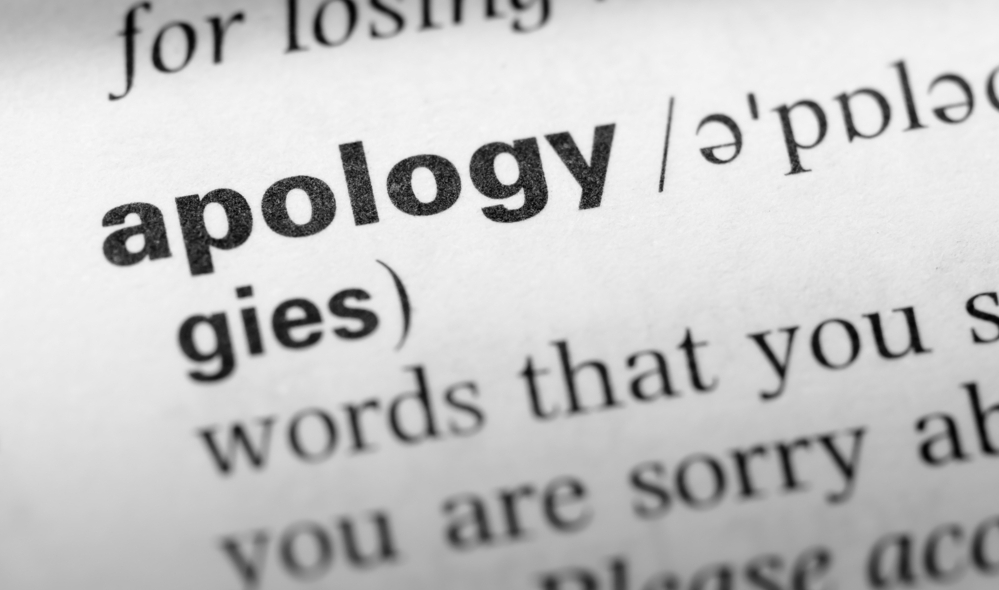#SorryNotSorry

Photo by TungCheung/Shutterstock
BY Sara Laux
November 16, 2018
Kevin Spacey: “I am sorry for the feelings he describes having carried with him all these years.”
Justin Trudeau: “It is with shame and sorrow and deep regret for the things we have done that I stand here today and say: We were wrong. We apologize. I am sorry. We are sorry.”
If you’re going to publicly apologize for something, there’s a good way (Justin Trudeau) and a bad way (Kevin Spacey) to do it, says Cognitive Science of Language grad Laura Beaudin. Her master’s thesis, “I Am Sorry, We Are Sorry” examines what makes a good public apology – and what makes a public apology sound like nothing more than an exercise in reputation management.
Unsuccessful – or, to use the academic term, “infelicitous” – apologies often use what are known as “non-apology strategies.”
These “fauxpologies” include saying things like “I’m sorry you feel that way,” “I’m not perfect – I made a mistake,” or “For whatever I did, I’m sorry” – phrases that tend to imply “I’m sorry, but…”, deflecting attention away from the act itself and any direct accountability for the apologizer.
— Kevin Spacey (@KevinSpacey) October 30, 2017
“Researchers have proposed that public apologies are not true apologies, because they tend to use ‘fauxpology’ strategies,” says Beaudin. “Public apologies are different from interpersonal apologies – you want to apologize for something, but you may also be protecting a company’s reputation, or doing damage repair. I thought maybe public apologies could be true apologies – we just needed a way to analyze them.”
Beaudin’s research showed that just because public apologies may serve a different purpose than simply saying “I’m sorry” when you bump into someone doesn’t mean they’re not actually apologies. Beaudin developed a framework to analyze seven apologies in three categories: corporate, celebrity and historical, and found that while all used some non-apology strategies, many also used true apology strategies, such as taking direct responsibility (“I’m sorry”) and making an offer of repair (“I will ask that an ethics review take place”) as well.
Take Prime Minister Justin Trudeau’s apology to the survivors of residential schools in Newfoundland and Labrador on Nov. 24, 2017– the second of five public apologies that Trudeau has made since taking office in 2015.
“One of the most common fauxpology strategies that I identified was distancing language, either referring to the event as ‘the event,’ or using passive language,” says Beaudin. “Trudeau used a lot of distancing language in his apology to the Innu, Inuit and NunatuKavut people – but that’s appropriate in a historical apology where the speaker wasn’t directly involved in the event.”
Today, we apologize to former students of Newfoundland and Labrador residential schools and to the families, loved ones, and communities for the painful & tragic legacy these schools left behind: https://t.co/BKatosyFfM pic.twitter.com/PsJ30Zr6zj
— Justin Trudeau (@JustinTrudeau) November 24, 2017
Beaudin points out that, although he used some non-apology techniques, Trudeau also acknowledged that wrongdoing had happened, explicitly named what had happened and asked for forgiveness – all elements of a true, or “felicitous,” apology.
Since historical apologies tend to be scheduled in advance, Trudeau had the luxury of time on his side. Many public apologies, coming soon after an incident or exposure of wrongdoing, aren’t so lucky.
“With a lot of apologies, you don’t have all the facts in the amount of time that the public expects a response,” says Beaudin. “With internet culture, everyone expects everything to be immediate, so you often need to respond to any scandal or crisis before you’re ready, which can make it tough to make a good public apology.”
Beaudin says that while her research looks at apologies from an academic perspective, it’s important to remember that the purpose of apologies is to repair relationships – and that there are strong emotions involved.
“People who make public apologies need to be aware that it’s not going to be received by people who are in a completely neutral or positive headspace,” she points out. “They need to think about the humanity of it, and make sure that the apology isn’t the end of the discussion.”


